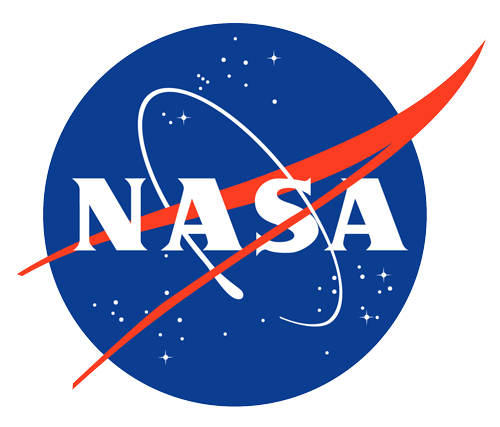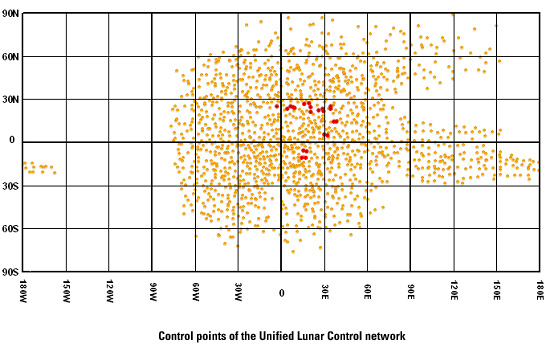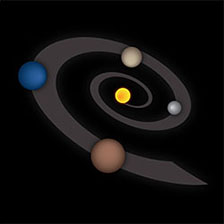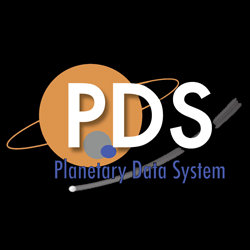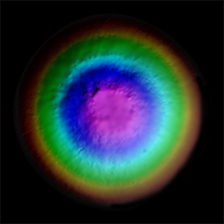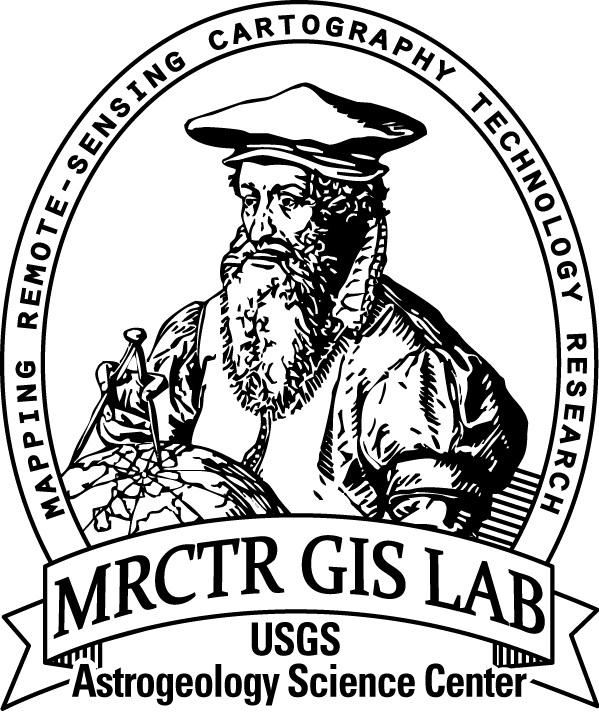Unified Lunar Control Network solution output files
- Originators
- USGS Astrogeology Science Center
- Publisher
- USGS Astrogeology Science Center
- Abstract
-
Lunar Orbiter Lunar Control Network 2004: The USGS worked to digitize and restore a global set of Lunar Orbiter images and to assemble this into a global digital Lunar Orbiter mosaic of the Moon. A separate Lunar Orbiter Control network is being created as part of this work. For additional information, see the Lunar Orbiter Digitization Project [Gaddis et al., 2001a, 2001b, 2003; Becker et al., 2004].
Unified Lunar Control Network 2004: Work by B. Archinal, M. Rosiek, and others at USGS was done to unify the ULCN and CLCN [Archinal and Rosiek, 2004], and to attempt to eliminate the large offsets in the CLCN. This was done by constraining as many ULCN points as possible within the CLCN, by using reasonable camera angle constraints (e.g. the 0.03 degree stated accuracy of Clementine pointing), and solving for tie point positions with realistic (at least +/- 1-2 km) radii, based on the current USGS lunar radii model [Rosiek et al. 1998; Rosiek and Aeschliman, 2001; Rosiek et al. 2001]. Still, we estimate that the horizontal accuracy of points in this network will still range from, at best, the 100 m to 3 km level of the ULCN, and accuracies of even more than 3 km will still be possible in areas away from the ULCN (e.g. on much of the far side).
Unified Lunar Control Network (1994): The ULCN was described in the last major publication about a lunar control network [Davies et al., 1994]. This sparse network contains 1478 points, 1286 points on the near side and 192 points on the far side (Figure 1). Images for this network are from the Apollo, Mariner 10, and Galileo missions, and from Earth-based photographs. The expected horizontal position accuracy of points in this system runs from 100 m to 3 km, depending on the original image source. The importance of this network is that this accuracy is relatively well quantified and published information on the network is available.
The files from this network were transferred to the U. S. Geological Survey in 2000, as part of the transfer of geodesy work from RAND to USGS in 2000-2001 [Archinal et al., 2000, 2001, 2002a, 2002b, 2003]. They have also been made available upon request from either RAND or USGS.
Notes: The data in this file were originally published on microfiche as a part of Davies et al. [1994]. Diacritical marks used for crater names are missing in this ASCII version. Another version of this file is available as part of the Lunar Consortium Dataset. Fields here include:
Control Point name; Set (1 - Apollo Network, 2 - Telescopic Network, 3 - Mariner 10 Network, and 4 - Galileo Network); Crater name if any; latitude in degrees; longitude in degrees; and radius in km (* indicates the radius was derived from Apollo altimetry).
Following are references cited in the above text, as well as various other references on the subject of lunar control networks.
- Archinal, B.A., M. E. Davies, T. R. Colvin, T. L. Becker, R. L. Kirk, and A. R. Gitlin, 2000, A New RAND-USGS Control Network and Size Determination for Io, Eos Trans. AGU (suppl.), 81, p. F317.
- Archinal, B. A., M. E. Davies, T. R. Colvin, T. L. Becker, R. L. Kirk, and A. R. Gitlin, 2001, An Improved RAND-USGS Control Network and Size Determination for Io, Lunar Planet. Sci., XXXII: Lunar and Planetary Institute, Houston, Abstract no. 1746, [CD-ROM].
- Archinal, B. A., T. R. Colvin, M. E. Davies, R. L. Kirk, T. C. Duxbury, E. M. Lee, D. Cook, and A. R. Gitlin, 2002a, A MOLA-Controlled RAND-USGS Control Network for Mars, Lunar Planet Sci., XXXIII, Lunar and Planetary Institute, Houston, Abstract no. 1632 [CD-ROM].
- Archinal, B. A., 2002b, Planetary Geodesy: The Mapping of Mars at Global to Local Scales, Weikko A. Heiskannen Symp. in Geodesy, The Ohio State University, Columbus, Abstract no. 11.4 [CD-ROM].
- Archinal, B. A., R. L. Kirk, T. C. Duxbury, E. M. Lee, R. Sucharski, and D. Cook, 2003, Mars Digital Image Model 2.1 Control Network, Lunar Planetary Sci., XXXIV: Lunar and Planetary Institute, Houston, abstract no. 1485 [CD-ROM].
- Archinal, B. A., and M. Rosiek, 2004, Unified Lunar Control Network 2004, in preparation.
- Becker, T. L., K. E. Edwards, D. Cook, E. Eliason, E. M. Lee, A. S. McEwen, H. Morgan, M. S. Robinson, T. Colvin, M. Davies, T. Duxbury, and T. Sorensen, 1996, A New Global Digital Map of the Moon from Clementine Image Data, Bulletin of the American Astronomical Society, Vol. 28, p.1121.
- Becker, T., L. Weller, L. Gaddis, D. Soltesz, D. Cook, A. Bennett, D. Galuska, B. Redding, J. Richie, 2004, Progress on Reviving Lunar Orbiter: Scanning, Archiving, and Cartographic Processing at USGS, Lunar Planet Sci. XXXV: Lunar and Planetary Institute, Houston, abstract no. 1791 [CD-ROM].
- Bowker, D.E. and J.K. Hughes, 1971, Lunar Orbiter Photographic Atlas of the Moon, NASA SP-206.
- Cook, A.C., T. R. Watters, M. S. Robinson, P. D. Spudis, and D. B. J. Bussey, (2000), Lunar polar topography derived from Clementine stereo imagery, Journal of Geophysical Research, Vol. 105, No. E5, Pages 12,023-12,033, May 25.
- Cook, A. C., B. Semenov, M. S. Robinson, and T. R. Watters, 2002a, Assessing the absolute positional accuracy of the Clementine UVVIS mosaic, Microsymposium 36, #107.
- Cook, A. C., M. S. Robinson, B. Semenov, and T. R. Watters, 2002b, Preliminary Analysis of the Absolute Cartographic Accuracy of the Clementine UVVIS Mosaics, American Geophysical Union, Fall Meeting 2002, Abstract no. P22D-09.
- Davies, M. E., T. R. Colvin, and D. L. Meyer, 1987, A unified lunar control network: The Near Side, Journal of Geophysical Research, Vol. 92, pages 14,177-14,184.
- Davies, M. E., T. R. Colvin, D. L. Meyer, and S. Nelson, 1994, The unified lunar control network: 1994 version, Journal of Geophysical Research, Vol. 99, No. E11, pages 23,211-23,214. November 25.
- Davies, M. E., and T. R. Colvin, 2000, Lunar Coordinates in the regions of the Apollo landers, Journal of Geophysical Research, Vol. 105, No. E8, pages 20,277-20,280.
- Defense Mapping Agency, 19XX?, Catalog of Lunar Positions, Based on the Lunar Positional Reference System (1974), Aerospace Center, St. Louis, Missouri.
- Edwards, K. E., T. R. Colvin, T. L. Becker, D. Cook, M. E. Davies, T. C. Duxbury, E. M. Eliason, E. M. Lee, A. S. McEwen, H. Morgan, M. S. Robinson, and T. Sorensen, 1996, Global Digital Mapping of the Moon, Lunar and Planetary Conference XXVII: Houston, Lunar and Planetary Institute, 335.
- Eliason, E. M., et al., 1997, Production of Digital Image Models, Lunar Planet Sci., XXVIII: Lunar and Planetary Institute, Houston, Abstract, pages 331-332.
- Eliason, E. M., A. S. McEwen, M. S. Robinson, E. M. Lee, T. Becker, L. Gaddis, L. A. Weller, C. E. Isbell, J. R. Shinaman, T. Duxbury, E. Malaret, 1999, Digital processing for a Global Multispectral Map of the Moon from the Clementine UVVIS Imaging Instrument, Lunar Planet. Sci., XXX: Lunar and Planetary Institute, Houston, Abstract no. 1933 [CD-ROM].
- Eliason, E., C. Isbell, E. Lee, T. Becker, L. Gaddis, A. McEwen, M. Robinson, 1999, Mission to the Moon: The Clementine UVVIS Global Lunar Mosaic, PDS Volumes USA_NASA_PDS_CL_4001-4078, produced by the U.S. Geological Survey and distributed on CD media by the Planetary Data System (released 4/00).
- Eliason, E. M., E. M. Lee, T. L. Becker, L. A. Weller, C. E. Isbell, M. I. Staid, L. R. Gaddis, A. S. McEwen, M. S. Robinson, T. Duxbury, D. Steutel, D. T. Blewett, and P. G. Lucey, 2003, A Near-Infrared (NIR) Global Multispectral Map of the Moon from Clementine, Lunar Planet. Sci., XXXIV: Lunar and Planetary Institute, Houston, Abstract no. 2093, [CD-ROM].
- Gaddis, L.R., T. Sucharski, T. Becker, and A. Gitlin, 2001a, Cartographic processing of digital Lunar Orbiter data, Lunar Planet. Sci. XXXII: Lunar and Planetary Institute, Houston, Abstract no. 1892, [CD-ROM].
- Gaddis, L.R., T. Becker, T. Sucharski, A. Gitlin, R. Kirk, and A. Howington-Kraus, 2001b, Lunar Orbiter: Digitization and Cartographic Processing, [abs.], in Planetary Mapping 2001, International Society for Photogrammetry and Remote Sensing, Working Group IV/9: Flagstaff, Arizona, web publication.
- Gaddis, L., T. Becker, L. Weller, D. Cook, J. Richie, A. Bennett, B. Redding, and J. Shinaman, 2003, Reviving Lunar Orbiter: Scanning, archiving, and cartographic processing at USGS, Lunar Planet. Sci. XXXIV: Lunar and Planetary Institute, Houston, Abstract no.1459, [CD-ROM].
- Gutschewski, G. L., D. C. Kinsler, and E. Whitaker, 1971, Atlas and Gazetteer of the Near Side of the Moon, NASA SP-241, U. S. Government Printing Office, Washington.
- Hansen, Thomas P., 1970, The Guide to Lunar Orbiter Photographs, Langley Research Center, NASA SP-242.
- Isbell, C. E., E. M. Eliason, T. Becker, E. M. Lee, A. McEwen, and M. Robinson, 1997, The Clementine Mission: an Archive of a Digital Image Model of the Moon, in Lunar Planet. Sci., XXVIII: Lunar and Planetary Institute, Houston, page 623.
- Isbell, C. E., et al., 1999, Clementine: A Multi-Spectral Digital Image Model Archive of the Moon, Lunar Planet Sci. XXVIII: Lunar and Planetary Institute, Houston, pages 1812-1813.
- King, R. W., Counselman, C. C., III, and Shapiro, I. I., 1976, Lunar dynamics and selenodesy: Results from analysis of VLBI and laser data, J. Geophys. Res., v. 81(35), 6251-6256.
- Lunar Exploration Science Working Group (LExSWG), 1992, A Planetary Science Strategy for the Moon, Solar System Exploration Division, Lyndon B. Johnson Space Center, Houston. JSC-25920. July.
- Lunar Geoscience Observer Workshop Members, 1986, Contributions of a Lunar Geoscience Observer (LGO) Mission to Fundamental Questions in Lunar Science, Department of Geological Sciences, Southern Methodist University, Dallas. March.
- Malin, M. and M. Ravine, 1998, Clementine High Resolution Camera Mosaicking Project, Technical Report, Malin Space Science Systems San Diego.
- Meyer, D. L., 1980, Selenocentric control system (1979), DMA Tech Report 80-001, Defense Mapping Agency, St. Louis, Missouri.
- Neumann, G. A., F. G. Lemoine, and M. H. Torrence, 2002, Laser Altimetry and the Cartography of Mars, Moon, and 433 Eros, American Geophysical Union, Fall Meeting 2002, Abstract no. P21A-363.
- Nozette, S. and 34 others, 1994, The Clementine mission to the Moon: scientific overview, Science 266, 1835-1839.
- Rosiek, M. R., Kirk, R. L., and Howington-Kraus, E. T., 1998, Lunar topographic maps derived from Clementine imagery, Lunar Planet. Sci., XXX: Lunar and Planetary Institute, Houston, Abstract no. 1853 [CD-ROM].
- Rosiek, M. R, and Aeschliman, R. A., 2001, Lunar shaded relief map updated with Clementine data, Lunar Planet. Sci., XXXII: Lunar and Planetary Institute, Houston, Abstract no. 1943 [CD-ROM].
- Rosiek, M. R., Kirk, R. L., and Howington-Kraus, E. T, 2001, Combining lunar photogrammetric topographic data with Clementine Lidar data [abs.], in Planetary Mapping 2001, International Society for Photogrammetry and Remote Sensing, Working Group IV/9: Flagstaff, Arizona, web publication.
- Schimerman, Lawrence A., ed., 1973, Lunar Cartographic Dossier, Volume I, NASA and the Defense Mapping Agency, St. Louis, Missouri. With changes and additions to 1977 July.
- Shelus, P., 2003, Lunar Laser Ranging, in Pearlman, M., and Noll, C., eds., International Laser Ranging Service 2002 Annual Report, ILRS, TP-2003-212239, September.
- Smith, D. E., Zuber, M. T., Neumann, G. A., and Lemoine, F. G., 1997, Topography of the Moon from the Clementine Lidar: Journal of Geophysical Research, v. 102, no. E1, p. 1591-1611.
- USGS, 1997, Clementine Basemap Mosaic, USA_NASA_PDS_CL_30xx, NASA Planetary Data System.
- USGS, 2002, Color-Coded Topography and Shaded Relief Maps of the Lunar Hemispheres, Geologic Investigations Series I-2769, U. S. Geological Survey.
- Williams, J. G., X X Newhall, and J. O. Dickey, 1987, Lunar gravitational harmonics and reflector coordinates, in Proceedings of the International Symposium, Figure and Dynamics of the Earth, Moon, and Planets, pages 643-648, Astronomic Institute of the Czechoslovak Academy of Sciences and Research Institute of Geodesy, Topography and Cartography, Prague.
- Willoughby, N. J., A. C. Cook, and M. S. Robinson, 2004, Semi-Automated Extraction of Contours from Lunar Topographic Maps, Lunar Planet. Sci., XXXV: Lunar and Planetary Institute, Houston, Abstract no. 2040 [CD-ROM].
Acknowlegements
The research descriped here has been funded in part bye the NASA Planetary Geology and Geophysics Program.
For Information, Contact:
Brent Archinal
Geodesit
barchinal@usgs.gov
2255 N. Gemini Drive
Flagstaff, AZ 86001
928 556 7083
Contact and Distribution
- Format
- Control Network
- Access Scope
- Astrogeology
- Native Data Set Environment
- Astrogeology Theme
- Geographic Information System (GIS)
- Mission Names
- Lunar Reconnaissance Orbiter
- Online Package Link
- https://astrogeology.usgs.gov/search/map/unified_lunar_control_network_solution_output_files
- External File Size
- 120161
- Online File Link
- http://astropedia.astrogeology.usgs.gov/download/Moon/Research/ControlNetworks/total-edited.dat
- Contact Address
- 2255 N. Gemini Drive
- Contact City
- Flagstaff
- Contact State
- AZ
- Contact Postal Code
- 86001
- Contact Email
- astroweb@usgs.gov
Geospatial Information
- Target
- Moon
- System
- Earth
- Object Type
- Grid Cell
- Quad Name
- Horizontal Coordinate System Units
- Degrees

